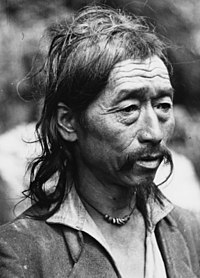Lepcha people

A Lepcha man
|
|
| Total population | |
|---|---|
| (30,000–50,000 (2007)) | |
| Regions with significant populations | |
| Languages | |
| Lepcha, Sikkimese (Dranjongke), Dzongkha, Nepali | |
| Religion | |
| Mun, Buddhism |
The Lepcha are also called the Rongkip meaning the chidren of God and the Rong, Mútuncí Róngkup Rumkup (Lepcha: ᰕᰫ་ᰊᰪᰰ་ᰆᰧᰶ ᰛᰩᰵ་ᰀᰪᰱ ᰛᰪᰮ་ᰀᰪᰱ; "beloved children of the Róng and of God"), and Rongpa (Sikkimese: རོང་པ་), are among the indigenous peoples of Sikkim and number between 30,000 and 50,000. Many Lepcha are also found in western and southwestern Bhutan, Tibet, Darjeeling, the Mechi Zone of eastern Nepal, and in the hills of West Bengal. The Lepcha people are composed of four main distinct communities: the Renjóngmú of Sikkim; the Támsángmú of Kalimpong, Kurseong, and Mirik; the ʔilámmú of Ilam District, Nepal; and the Promú of Samtse and Chukha in southwestern Bhutan.
The word Lepcha(Myal kup) is considered to be the anglicized version of the Nepalese word lepche meaning "vile speakers" or "inarticulate speech". This was at first a derogatory nickname but is no longer seen as negative.
The origin of the Lepcha is unknown. They may have originated in Myanmar, Tibet or Mongolia but the Lepcha people themselves firmly believe that they did not migrate to the current location from anywhere and are indigenous to the region. They speak a Tibeto-Burman language which some classify as Himalayish. Based on this, some anthropologists suggest they emigrated directly from Tibet to the north, or from Eastern Mongolia. They were even said to be from Japan or Korea, while others suggest a more complex migration that started in southeast Tibet, a migration to Thailand, Burma, or Japan, then a navigation of the Ayeyarwady River and Chindwin rivers, a crossing of the Patkoi range coming back west, and finally entering ancient India. While migrating westward through India, they are surmised to have passed through southern Bhutan before reaching their final destination near Kanchenjunga. The Lepcha people themselves do not have any tradition of migration, and hence they conclude that they are aboriginal to the region, currently falling under the state of Sikkim, Darjeeling District of West Bengal, eastern Nepal and the southwestern parts of Bhutan. In the Mechi Zone, they form 7% of the population of Ilam District, 2% in Panchthar District, and 10% of the population in Taplejung District. In Sikkim as a whole they are considered to be around 15% of the population of the state.
...
Wikipedia
